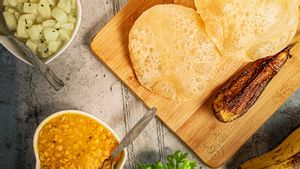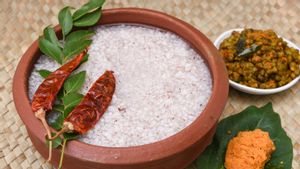In April, Assamese kitchens churn out Laru-pitha (Assamese pancakes and ladoos) by the kilo to celebrate the Assamese New Year and welcome the season of sowing. Rongali Bihu, aka a festival of colours, is marked by joyous singing and dancing. The week-long festivities are dedicated to bringing in more abundance and expressing gratitude to the year gone by.
The celebrations begin in the kitchen, where men, women and eager children come together to hand-grind fresh turmeric, soaked black gram, sesame and sticky rice. In the age of electronic mixers and grinders, the sticky rice of Assam would become a dry and lifeless powder unless lovingly hand-pounded to make the perfect base for pitha.
Fresh coconuts are scraped, milk is readied to make wholesome thick curd, and a final dash to the market for jaggery and mustard oil without which Assamese dishes are incomplete. This enthusiastic preparation for the festival starts on the night of Uruka, the eve of Bohag Bihu.
Day 1: Goru Bihu
The first day of this four-day-long festival is known as Goru (cow) Bihu. It begins at the crack of dawn with families bathing the cattle. Most modern families don’t have cattle, but that doesn’t make the celebration any less authentic. Those who do, scrub the animals with a paste of fresh turmeric and black gram before bathing them. Once done, each family member uses the turmeric as a body scrub and black gram to wash their hair. Turmeric is known for its potent antibacterial and antifungal properties. It also brims with anti-ageing nutrients.
A Poita Bhaat breakfast (leftover cooked rice soaked in water overnight) with salt, onion and chilli is served traditionally. It’s believed to have more micronutrients than fresh rice. Interestingly, an Assam Agricultural University study found that 100 g of poita bhaat, fermented for 12 hours, contains up to 73.91 mg of iron, while the same quantity of fresh rice contains only 3.4 mg.
“The overnight soaking leads to slight fermentation imparting probiotic properties,” says Jyoti Das, author of the popular Assamese cookbook Ambrosia—From the Assamese Kitchen and winner of e-North East Award 2014 for Culture and Heritage. For lunch, Poita Bhaat is paired with vegetable curry or aloo pitika (mashed potato), bengena bhorta (brinjal bharta) or curd (doi). It can also be eaten at any other time of the day and year. It’s also a popular comfort food when one is recovering from an illness.
Day 2: Manuh Bihu
This is the day to come together as a family, visit ancestral homes to meet grandparents, and the extended family. It’s also the day to wear new clothes and gift new weaves to kith and kin. Women drape the traditional Mekhela Chadors and the elders are gifted handwoven gamuchas (traditional Assamese stole) with intricate floral designs.
A cornucopia of delicious homemade pithas is laid out on ban kaahis (bell metal plates). These include the Ghila pitha (sticky rice pancakes flavoured with jaggery and fried in mustard oil), Tekeli pitha (rice pancake steamed on the mouth of a kettle), til pitha (roasted sticky rice rolls stuffed with sesame and jaggery), narikol pitha (sticky rice roll stuffed with coconut and jaggery), til laddus, coconut laddus, bhap pitha (steamed rice pancakes stuffed with coconut). Each pitha pairs deliciously well with a fresh cup of tea.
Lunch is almost always doi-seera (curd with jaggery and flattened rice) and is served in glistening bell metal bowls. Known as jolpan, the lip-smacking blend of curd and flattened rice sweetened with jaggery naturally cools the body. The entire day is about guilt-free feasting with family.
Day 3: Guxain Bihu
Day three is dedicated to the Gods and is known as Guxain Bihu. Farmers and families visit the namghor (traditional Assamese temples) to pray for a fresh start and the beginning of the sowing season. Food is almost always a vegetarian fare with light options and bingeing on Doi-seera and laru-pitha continuing.
Day 4: Sera Bihu
Sera Bihu is all about detoxifying after days of feasting. In spring, the Brahmaputra valley turns green with a wide variety of tender green leafy veggies or Xaak. “Assam was known as the land of 707 varieties of Xaak. Many are extinct today and we are left with 101 types,” informs Das. Some of these are Manimuni, Khutura, Lai, Paleng, Morissa, Mula, Jilmil, Dhekia, Mosur, Kola Kosu, Methi, Nohoru, Babori, Brahmi, Laijabori, Maan Dhania, Masundari, Pirali Paleng, Sajina Paat and Tengesi among others.
“Growing up, we would handpick these greens from my mum’s kitchen garden or in the wild (many varieties of Xaak grow in the wild). It can be eaten individually or a sabji of an odd number of xaaks is prepared,” she adds. Delectable meat and fish preparations with xaaks and green chillies are also common during the harvest season.
Xaak is an indispensable part of Assamese cuisine. They are rich in fibre and micronutrients and have immense medicinal value, particularly their immune system benefits. This is especially helpful in this season as the air is ridden with dust and pollen and allergies are common.
Something bitter
Eating something bitter on day four of Bohag Bihu is a common custom. It could be tita kerela (bitter gourd), neem paat (neem leaves), tulsi paat (Holy basil leaves), methi paat (fenugreek leaves)—all of which are gut healthy. Some families make a concoction of these greens to have as a detox juice.
If something were to be incorporated in a meal, it would be paired with Masoor daal and Kathalor musi (jackfruit curry) and the fragrant joha rice. Research now indicates that jackfruit is one of the most nutrient-dense foods. For farmers in Assam, jackfruit is a staple in this season. Panitenga and Kharoli are signature Assamese pickles made from ground mustard seeds and accompany any meal, like a jolokia (chilli) pickle.
There’s an interesting anecdote behind the spicy chicken curry (Jhaal Murgi) cooked in Lower Assam on this day. The farming community believes that this curry’s fieriness rids the body of aches from all the heavy lifting during sowing and ploughing season, says Das.
Fruits of the Season
Jackfruit and mango are in abundance and plucked just before they are ripe. The local mango, known as Jaati Aam, is susceptible to insects and birds, so people prefer to pluck them raw and turn them into chutney. At this time of the year, jackfruits are just the right size to be cooked into a sabji, pickle and cutlets.
Another popular item relished in this season is Koldil or banana flower, which is turned into a sabji or cutlets. Raw banana and Kaat aloo (wood-like potato) chips and fritters are popular savoury snack items along with xoru aloo (baby potatoes) cooked with fenugreek, salt and haldi.
Many new items appear on the plate to celebrate this agrarian festival along with regulars like Fish tenga (sour fish curry) and khar (alkali prepared with raw papaya and burning banana stem), though not always together.
It’s a festival that's all about making the most of the season’s freshest produce — power-packed foods that provide wholesome nutrition for the hot and humid summer ahead.




